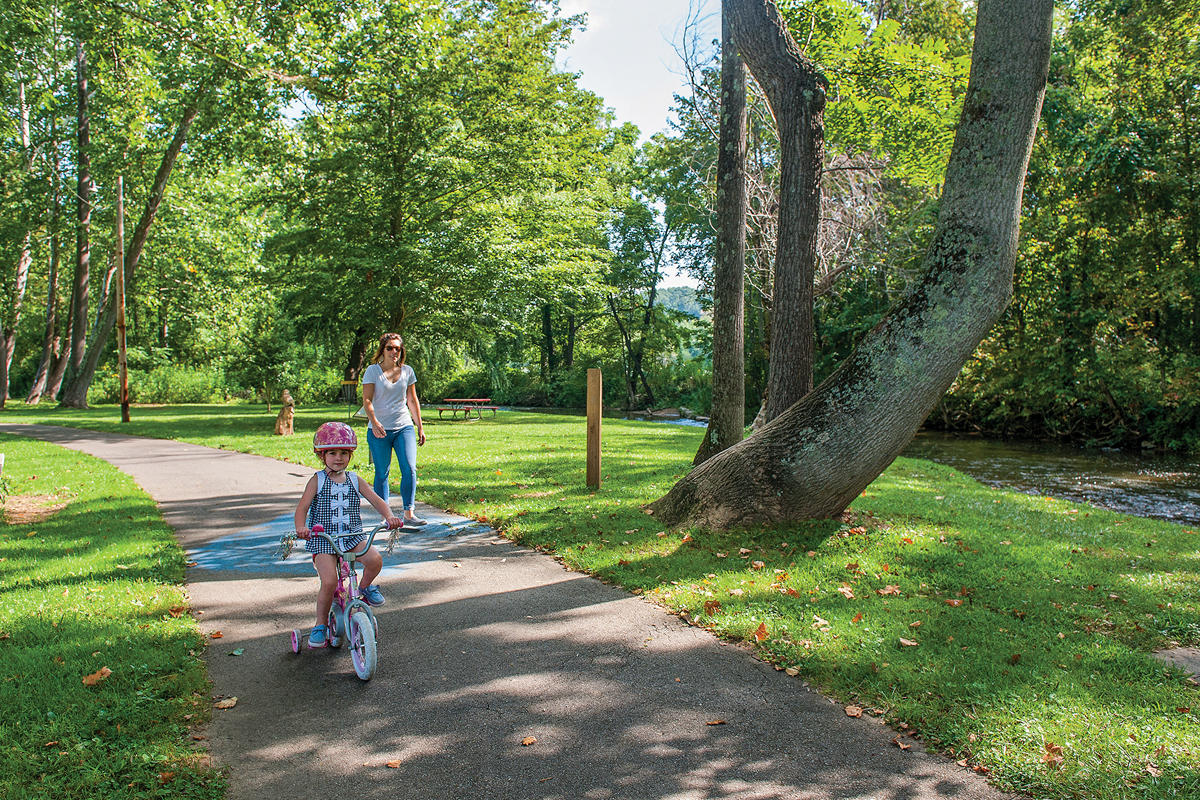TDA 2.0: Haywood’s tourism authority takes bold steps under new leadership
 Tourism in Western North Carolina continues to grow. File photo
Tourism in Western North Carolina continues to grow. File photo
She’s only been on the job for a few months, but the Haywood County Tourism Development Authority’s new executive director is already taking steps to streamline and refine the authority into an organization that’s proactive and premeditated, rather than reactive and organic.
“It’s an evolution, right? I have the advantage of being new,” said Corrina Ruffieux, whose hiring was announced in January. “And that advantage is, I look at things a little bit differently.”
Ruffieux comes from Elizabeth City to Haywood County at a time when tourism development authorities across the state are increasingly being asked to address the harmful impact of visitation on locals while simultaneously handling more money than ever before.
A recent economic report prepared for VisitNC by Tourism Economics shows that in calendar year 2022, travelers pumped more than $33.3 billion into North Carolina’s economy, a 15.2% jump over 2021. The majority of the spending comes on food and beverages, followed closely by lodging.
Haywood County’s share of those billions was about $336 million, good for a rank of 22 among the state’s 100 counties and up 4% from 2021. The county’s travel and tourism sector boasted an $85.2 million payroll that employed nearly 2,100 people resulting in more than $12.5 million collected in state taxes and $11.4 million in local taxes, or about $379 per resident.
Related Items
Occupancy tax collections, another good measure of visitor activity in the county, correlate closely with the growth in the state report.
For the 2022-23 fiscal year, which runs from July 1 to June 30, the HCTDA finally broke the $3 million mark with $3.04 million in collections, after just missing that mark in 2021-22 with $2.93 million in collections.
The latest collection numbers are essentially double those from just five years ago.
“I think Haywood County and probably a lot of rural Western North Carolina offer what people want, post-COVID,” Ruffieux said. “We have a product that the consumer wants. We have the outdoors, you can spread out, we’re in a great spot.”
That said, some counties have become victims of their own success, with anecdotal reports of tourists outstripping tourism infrastructure like bars, restaurants and even roads, making a great place to visit a difficult place to live.
Over the past few years, the tourism industry as a whole has learned some hard lessons on how to be less extractive.
“We’ve reinvested in projects that make Haywood County a better place to live, Chestnut Mountain being an example, the Richland Creek Greenway,” Ruffieux said about two of the five projects that received monies from the TDA’s $500,000 one-time special projects fund last July. “We haven’t solely funded those by any means, but partially funded, and those funding streams make a difference to the locals because now they have a product that they can enjoy as well.”
While that’s true, the biggest downside of the upswing in tourism spending for Haywood County residents has been a runaway housing market that’s pricing out locals — some of whom work in the lower-paying tourism economy.
The average sales price for a Haywood County home increased in July by 1.5% year-over-year to $401,183, according to Canopy MLS. In context, those figures actually compare favorably to the 15.2% increase in Buncombe County, where the average sales price is now more than $635,000, and the 9.9% increase in Jackson County, where the average sales price is currently $493,000.
Figures from the HCTDA show that during the exact same period the authority’s occupancy tax collections doubled, between 2018 and 2023, so did the number of short-term vacation rentals in the county.
Back in October 2014, there were only 48 whole-house short-term vacation rentals in Haywood County. By October 2018, that number had grown to 878. This past May, it was 1,707.
The rise of short-term vacation rentals is making it more difficult for social service agencies, like Haywood County’s Mountain Projects, to administer Section 8 vouchers, which don’t pay enough for landlords who can make three times as much renting out their properties just a few days a month.
“The whole vacation rental thing is a hot topic everywhere,” said Jim Owens, new chair of the TDA board and a Maggie Valley alderman who spent 45 years in high-level hospitality industry positions, including at the Biltmore and SeaWorld. “I don’t know how you address it, or if it needs to be addressed. There’s pros and cons. We’ve definitely seen an uptick, we’ve seen growth.”
There’s still no answer as to how TDAs can acknowledge the effect of tourism on the local housing market.
“That is a question that my peers all across the country are trying to answer. There’s a big lack of understanding of what occupancy tax dollars can and can’t be spent on, and it varies by state. Some states actually can spend it on affordable housing, but in North Carolina you can’t,” Ruffieux said. “That doesn’t mean we can’t educate people and work together to advocate for policies and procedures that really make a difference. I’m hoping that through our tourism master plan — that plan’s focus is going to be about actionable items that make Haywood County more attractive to visit but also a better place to live. Affordable housing is going to need to be a piece of that conversation because if we don’t have places for people to live, then they can’t work in our restaurants or hotels.”
Currently, an RFP is out for the tourism master plan Ruffieux mentioned, focusing on four main goals: encouraging sustainable growth that benefits visitors and residents; bolstering the local economy against shocks like the loss of 1,000 jobs at Pactiv Evergreen’s Canton paper mill; long-term conservation of natural and cultural assets; and identifying and plugging gaps in current infrastructure like amenities, accommodations and transportation.
“I think we have to learn as we go. We’ve never done a plan on a countywide level before,” Owens said.
Owens mentioned a robust master plan by Rutherford County, which includes progress reports, as a great example of what he’d like to see.
There’s also an RFP out for destination branding services that will start by evaluating the current perceptions of the county as a destination and end with the implementation of a brand standards manual complete with identity, messaging, new branding, logos and fonts.
For the first time, the HCTDA will contract with a public relations firm to work in conjunction with its existing ad agency, South Carolina-based Crawford Strategies. Board members accepted a proposed contract with MMGY-NJF, a globally-recognized firm specializing in travel and tourism. The contract is open-ended, cancellable with 90 days’ notice and runs about $7,000 a month plus expenses.
Some changes to the authority’s bylaws are also in the works. The group sales committee will be eliminated as it’s not a focus of the HCTDA right now, Ruffieux said, and never even met. Nor did the government relations committee. The biggest change in committee structure will be the elimination of the 1% subcommittees, which will be channeled into a new entity, the product development committee.
Currently, Haywood County’s room tax rate stands at 4%, despite several unsuccessful efforts to increase that in the past.
That 4% is split into two different pots of money. Into the first goes 75% of occupancy tax revenue. Two-thirds of that must be used for promotion of the county as a destination, with the remaining third used for tourism-related expenses.
Into the second pot goes the final 25% of occupancy tax revenue, which is further divided up into five separate pots, one each for the five zip codes — Canton, Clyde, Lake Junaluska, Maggie Valley and Waynesville — that collect room occupancy taxes. The amount of revenue for each of those zip codes depends solely on the occupancy taxes collected within those respective jurisdictions.
In each of those zip codes, the so-called 1% subcommittees must make spending decisions on two-thirds of the revenue for the promotion of their specific jurisdiction, and the final one-third on tourism-related expenses within the jurisdiction.
“There were five separate subcommittees, and they met once a year. From a staff perspective, that’s a lot of committees to manage, and it was difficult for the committees to be as effective as they could be because they met so infrequently,” Ruffieux said.
The new committee will meet on a more regular basis and will focus on grant policies and procedures as well as making funding recommendations to the HCTDA’s main board. However, the board will still have the final say on recommendations made by the product development committee.
The product development committee will also manage the master plan process.
“That way we have every municipality and county level of representation at those master planning meetings helping us pick the agency that we’re going to work with, and helping lead some of those big conversations,” said Ruffieux. “Tourism is leading the process for this plan, but it’s not tourism’s plan. It’s Haywood County’s plan.”









